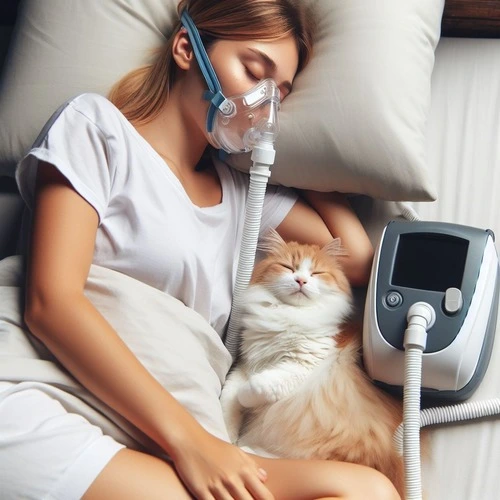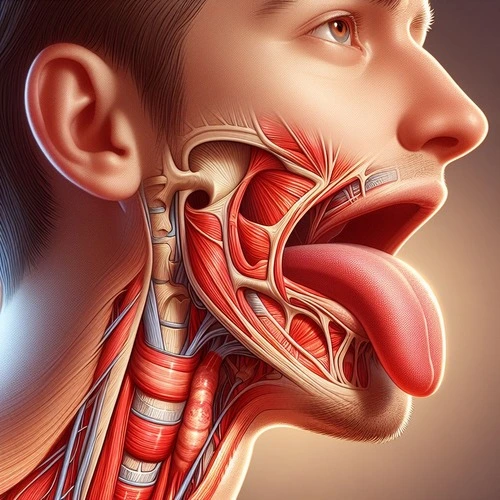Introduction
Sleep apnea, a condition that momentarily stops breathing during sleep, affects millions worldwide. Amidst various treatment discussions, one topic gaining attention is the role of tongue posture in managing this condition. This article aims to unravel the myths surrounding tongue posture and its impact on sleep apnea, offering readers a clear understanding and practical advice.
Understanding Sleep Apnea
Sleep apnea is a potentially dangerous sleep condition in which breathing stops or becomes shallow while you sleep. It’s possible for these breaks to last minutes or even seconds, and they can happen hundreds of times a night. The body might not get enough air as a result, which can cause many health problems if not fixed.
Different types of sleep apnea
The most common type is obstructive sleep apnea (OSA), which happens when the airway gets blocked because the muscles in the throat weaken.
CSA (central sleep apnea) happens when the brain doesn’t tell the muscles to breathe.
A mix of OSA and CSA is known as “mixed sleep apnea.”

Signs and symptoms of sleep apnea
-
Very loud snoring
-
Being too sleepy during the day
-
Feeling tired
- Headache in the morning
-
Having trouble concentrating
-
Irritation
Causes of Sleep Apnea Risk Factors
-
Overweight
-
Obstructive sleep apnea in the family
- If you are challenged by being male (increased risk factors)
-
Having a big neck circumference
-
Puffing
-
Using alcohol
Effects of Sleep Apnea on Health
If sleep apnea isn’t addressed, it can cause a number of major personal and health problems, such as:
-
Stressed-out heart
-
Heart illness
-
The stroke
-
Diabetes type 2
-
A feeling of depression
-
Automobile accidents
Depending on the severity of the problem and its root cause, there are various treatment choices for sleep apnea. Possible treatments are:
-
Making changes to your lifestyle, like stopping smoking, losing weight, and not drinking alcohol,
-
A machine called a continuous positive airway pressure (CPAP) machine keeps your airway open while you sleep by delivering compressed air.
-
For example, mouthguards are oral tools that can help keep the airway open.
-
Surgery to remove tissue or make the airway bigger.
The Role of Tongue Posture in Sleep
Defining Tongue Posture
Tongue posture refers to the position of the tongue in the mouth, especially during rest.


Impact on Airways
People often don’t realize how much bad tongue position can affect their sleep by blocking their passageways. This problem gets worse at night when you’re sleeping. Think of the tongue as a soft, bendable wall. When sleeping on your back or in some other position, it’s easy for the tongue to slip back into your throat. This unintended change stops the smooth flow of air, which causes the stop-and-start breathing that is a sign of sleep apnea.
This blockage isn’t just a bother; it’s also bad for your health. Every break in breathing, no matter how short, throws off the body’s normal sleep routine and oxygen levels. Over time, this can cause a number of problems, from tiredness during the day to more major heart problems.
But there is a bright side to this story. We can lower some of these risks by being aware of and consciously changing how the tongue is positioned. The tongue can be trained to stay in a position that helps the lungs stay clear through simple exercises and thoughtful practices.
Even though it’s not a magic bullet, this method is an important part of a larger plan to deal with and lessen the bothersome and possibly dangerous effects of sleep apnea. It may not seem like much to add these habits to your daily life, but they can make a big difference in how well you sleep and your general health.
Debunking Myths about Tongue Posture and Sleep Apnea
Myth 1: Cure-All Solution
Contrary to popular belief, correct tongue posture alone cannot cure sleep apnea, nor can single medical interventions. Every person is different, the condition affects every person differently, and there are different challenges for each person to manage.
There is nothing like a “quick fix,” and there is nothing that is a standalone solution. A course of treatment, lifestyle changes, and therapy are all necessary to improve your health.
Myth 2: Ineffectiveness of Tongue Exercises
While it’s clear that tongue posture alone isn’t a magic bullet for curing sleep apnea, there’s growing interest in how strengthening the tongue and other oral muscles can aid in its management. This is where myofunctional therapy comes into play. We will discuss this in great depth in just a moment.
Effective Management of Sleep Apnea
Lifestyle Changes
Managing your weight well is one of the most important things you can do to make your sleep apnea problems better. Extra weight, especially around the neck, can make it more likely that your airways will get blocked while you sleep, which can cause you to have more apnea events. Sticking to a healthy diet and daily exercise routine will not only help you lose weight, but it will also help your breathing and sleep.
Changing your bed position can help with sleep apnea in a surprising way, along with losing weight. People who have sleep apnea often feel better when they don’t sleep on their backs, because that pose can make the tongue and soft palate fall into the airway. Lying on your side while you sleep can help keep your airway open. Side sleepers can stay in that position all night with the help of special pillows and body supports.
These changes to your lifestyle may seem like small things, but they can help a lot with managing sleep apnea. They work with medical treatments and help with a more complete plan for better sleep health.
Medical Interventions
CPAP machines and surgical options remain primary treatments for severe cases.
How to Treat Sleep Apnea Effectively
Adding tongue exercises to treatment plans
Medical treatments for sleep apnea, like CPAP machines and possible surgery choices, get a lot of attention. But tongue exercises are just as important and shouldn’t be forgotten. This set of movements, which are part of a treatment called “myofunctional therapy,” helps with the overall treatment of sleep apnea.


How to Understand Myofunctional Therapy
Myofunctional therapy is a set of movements that are meant to make the muscles in your tongue and mouth stronger and more flexible. The main goal of this treatment is to improve the position of the tongue, breathing, and eating.
Why myofunctional therapy is important for people with sleep apnea
-
Tongue Strengthening: These activities help keep your airway open while you sleep by strengthening your tongue. This can lower the number and severity of sleep apnea episodes.
-
Improved Tongue Positioning: These exercises help you keep your tongue in the right position, which keeps it from going back into your throat, which is a typical way for people with sleep apnea to block their airways.
-
Better breathing patterns: myofunctional treatment teaches the right way to breathe, promoting nose breathing over mouth breathing, which is good for sleep quality.
It is important to set reasonable goals. Myofunctional treatment can be a useful part of a complex plan to deal with sleep apnea. But it’s not a magic bullet. The way it works for each person is different, and it works best when used with other treatments.
For a complete treatment of sleep apnea, you should think about a number of choices, including making changes to your lifestyle, like losing weight and not drinking alcohol before bed, medical devices like CPAP, and extra therapies, like myofunctional therapy. This all-around method makes sure that all parts of the disorder are dealt with, which leads to better general health and better management.
Practical Tips for Better Sleep and Better Overall Health
Daily Habits
Establishing a regular sleep schedule and avoiding alcohol before bedtime can improve sleep quality.
Tongue Positioning Techniques
If applicable, practicing correct tongue posture might offer some relief.
Seeking Medical Advice
Consult a healthcare professional for personalized treatment plans.
Conclusion
Understanding the myths and realities of tongue posture in relation to sleep apnea is crucial. While not a panacea, proper tongue posture, alongside other treatments and lifestyle changes, can contribute to better management of sleep apnea. Remember, a holistic approach is key to improving sleep quality and overall health.
Top Ten Questions and Answers
-
How does tongue posture affect sleep apnea?
- Tongue posture can influence the airway’s openness during sleep. An improper tongue position might obstruct the airway, exacerbating sleep apnea symptoms.
-
Can correcting tongue posture cure sleep apnea?
- While improving tongue posture may help manage symptoms, it is not a standalone cure for sleep apnea. Comprehensive treatment often requires lifestyle changes and, in some cases, medical intervention.
-
What are some effective tongue exercises for sleep apnea?
- Exercises like tongue slides, suctioning the tongue against the roof of the mouth, and tongue stretching can strengthen tongue muscles, potentially reducing apnea episodes.
-
Is sleep apnea only a night-time problem?
- While symptoms primarily occur during sleep, the effects of sleep apnea, like daytime fatigue and cardiovascular issues, can impact daytime wellbeing.
-
Does sleep position affect sleep apnea?
- Yes, sleep position can affect sleep apnea. Sleeping on the back can worsen symptoms, while side-sleeping may alleviate them.
-
Are there any lifestyle changes that help with sleep apnea?
- Weight management, avoiding alcohol before bedtime, maintaining a regular sleep schedule, and quitting smoking can all help mitigate sleep apnea symptoms.
-
How do CPAP machines help with sleep apnea?
- CPAP (Continuous Positive Airway Pressure) machines keep airways open by delivering a steady stream of air through a mask, reducing apnea episodes.
-
Can children have sleep apnea, and does tongue posture affect them?
- Yes, children can have sleep apnea. Tongue posture might play a role, but other factors like enlarged tonsils are more common causes in children.
-
What are the long-term risks of untreated sleep apnea?
- Untreated sleep apnea can lead to serious health issues, including hypertension, heart disease, stroke, and type 2 diabetes.
-
Can dental devices help with sleep apnea?
- Certain dental devices designed to adjust the lower jaw and tongue’s position can help reduce sleep apnea symptoms in mild to moderate cases.


